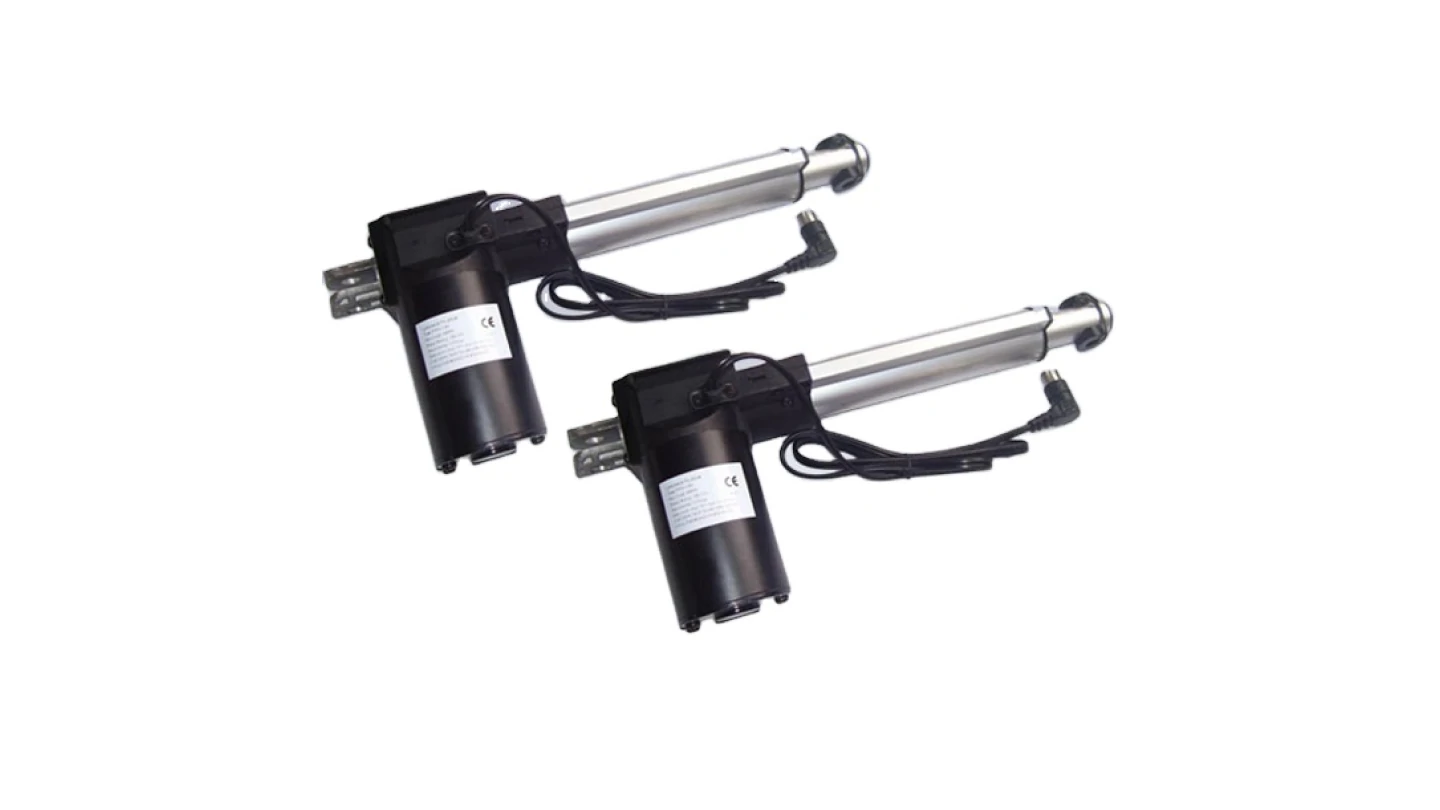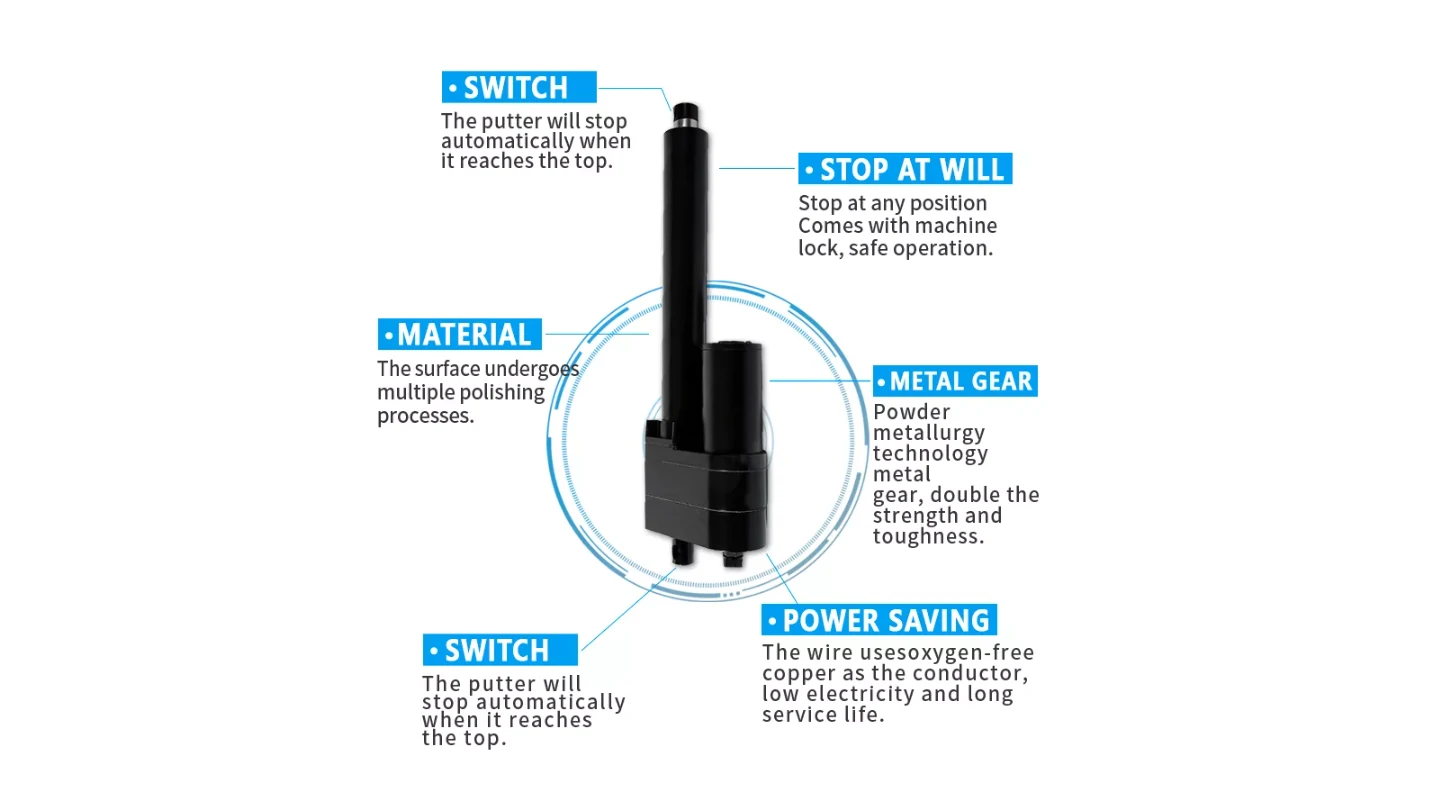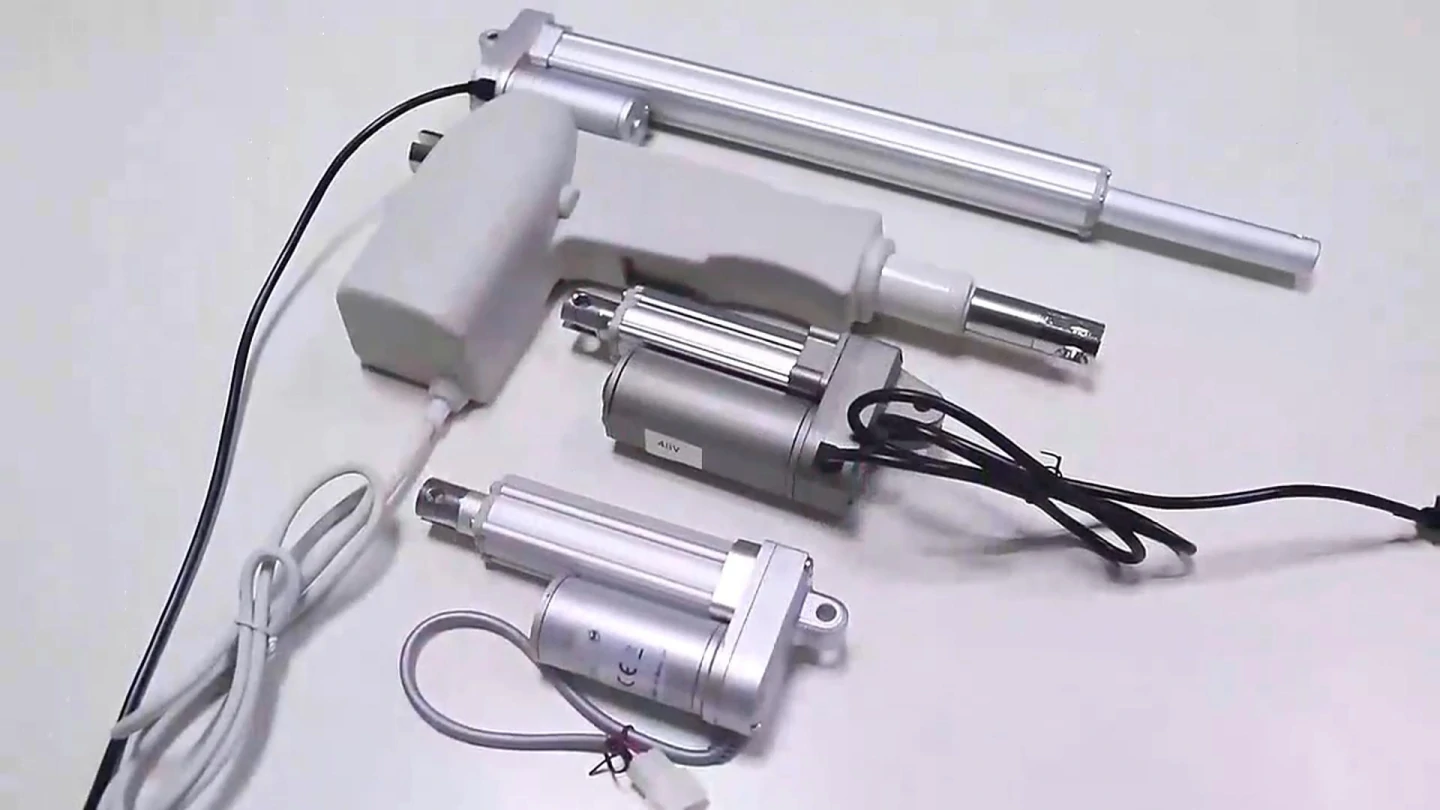In the modern industrial and automation fields, linear actuators, as a key mechanical device, have become the core of many technical applications due to their precise control and reliable performance. Now, please join me in delving into the world of linear motion, to gain a deeper understanding of linear actuators and meet your needs.
What is a linear actuator?
A linear actuator is a motion device that generates force and movement along a straight line. Linear actuators consist of a rotating motor (step motor, brushed DC motor, or brushless servo motor) and a threaded lead screw with a precision nut. When the motor rotor rotates, the linear actuator converts the motor’s rotation into linear motion by moving the nut along the lead screw in a straight line. The push-pull linear motion is achieved directly through the nut and the lead screw.

What is the function of a linear actuator?
Linear actuators provide linear motion that can be used to lift, lower, slide, adjust, tilt, push, or pull objects with just the press of a button. Today, there are hundreds of millions of linear actuators worldwide used to perform different tasks. Linear actuators can open automatic doors. They can adjust car seats. They are used to move patients through MRI machines and CT scanners. Linear actuators provide the back-and-forth motion for thousands of items people use every day, involving a multitude of industries such as manufacturing, robotics, healthcare, automotive, aerospace, and home automation.
The Working Principle of Linear Actuators
Linear actuators drive or move in a straight line. The primary reason for designing linear actuators in a system is to meet the need for precise movement of a payload in a linear rather than rotational manner. The operation of a linear actuator is quite straightforward. The lead screw (or ball screw) converts the clockwise and counterclockwise rotational force (torque) of the motor into back-and-forth linear motion of the nut that moves along the length of the screw.
When the motor turns the gear reducer, it causes the lead screw to rotate. The nut is threaded onto the lead screw, and as the lead screw rotates, the nut moves along the length of the lead screw. This motion is converted into linear motion, which can be used to push, pull, or lift objects. The conversion from rotational to linear motion is achieved using the lead screw and nut mechanism. The lead screw has a specific pitch, which determines the amount of linear movement per rotation of the motor. By controlling the speed and direction of the motor, the linear motion of the actuator can be precisely controlled.
Basic structure of a linear actuator

The main components of a linear actuator include:
- Motor: Provides the driving force, which can be either a DC or AC motor.
- Gearbox: Reduces the motor speed and increases torque output.
- Screw: A threaded rod that converts rotational motion into linear motion. Nut: Rides on the screw, converting rotational motion into linear displacement.
- Housing: Protects the internal components, usually made of metal or plastic.
- Control components: Include switches, sensors, and controllers for regulating the operation of the actuator.
What types of linear actuators are there?
Linear actuators are classified based on specifications such as load capacity, stroke length, speed, precision, and power consumption. They can be divided into light-duty, medium-duty, and heavy-duty to meet various application requirements. Stroke lengths are categorized into short-stroke and long-stroke to accommodate different ranges of linear motion. Additionally, there are actuators specifically designed for certain industries, such as medical, automotive, and aerospace.
Based on mechanical drive mechanisms, guide rails, and housings, they can be classified as follows:
- Hybrid Stepper Motor Linear Actuators — The preferred choice for equipment designers who require high performance and durability in a very compact package.
- Dual-Motion — Provides independent linear and rotary motion through a single compact actuator component. This type of actuator is an ideal replacement for bulky and complex mechanisms.
- Stacked Stepper Motor Linear Actuators — Offer a wider range of thrust and speed to meet a broader spectrum of applications.
- External Linear Actuators — The screw is fixed onto the motor shaft. This type is typically used to power linear sliding systems with a stroke range of 60-500 millimeters.
- Non-Captive Linear Actuators — The nut is placed inside the motor, allowing the screw to move linearly through the actuator. This type is typically suitable for stroke lengths of 30-200 millimeters.
- Captive Linear Actuators — The nut is located within the actuator body (similar to non-captive actuators), but with a linear spline attached to the front side of the screw, preventing the screw from rotating and providing linear output.
- Electromechanical Actuators — Combine a motor with an external linear drive element, which can be a ball screw, guide rod, rack and pinion, or belt. It may also include a gearbox and linear guidance elements.
- Hydraulic Actuators — A hydraulic cylinder with a piston that uses the unbalanced pressure of an incompressible fluid on the piston to produce linear displacement.
- Pneumatic Actuators — Use compressed air to convert energy into mechanical motion. They consist of a piston, cylinder, and valves or ports that can produce linear or rotary mechanical motion.
- Voice Coil Actuators — Have a magnet that produces a magnetic field, the field generates current, and the current moves the coil, resulting in motion on the axis. The force of the motion is proportional to the number of turns in the coil.

How to Choose the Right Linear Actuator?
To correctly determine the size of a linear actuator, the following variables must be considered:
- What linear force is required to move the load?
- What is the linear distance the load must travel?
- How much time is needed to perform this action?
- What criteria should designers consider when evaluating linear actuators?
When selecting a linear actuator, the following capabilities should be analyzed:
- High repeatability
- Positioning accuracy
- Smooth operation
- Long life
- Ease of maintenance (or lack thereof)
- Robustness and reliability in harsh environments
- Compact design
- Safe operation
- Versatility.
What is the load capacity of a linear actuator?
The load capacity of a linear actuator depends on its ability to move and hold a load. Load refers to the force pushing against or compressing the linear actuator, as well as the force pulling away from the linear actuator. The International Organization for Standardization (ISO) standard 14728-1:2017 describes the load fatigue of linear actuators.
There are two methods of measuring the load capacity of a linear actuator: dynamic and static. When a linear actuator is in a dynamic position, it is moving. When a linear actuator is in a static position, it is holding the load in a set position. The static load capacity depends on how much load the actuator can safely withstand without reversing or getting damaged.
How long can a linear actuator last?
With proper application considerations, Borman linear actuators can offer up to 20 million cycles. Motor fatigue will be determined by the unique application of each customer.
What are the advantages of Borman's linear actuators?
Borman’s linear actuators have the following advantages:
- Possessing Professional Certifications: Borman has numerous international certifications, including CE, UL, ISO9001, and ROHS.
- High Speed: DC and AC linear actuators have high operating speeds, enabling rapid movement.
- Flexibility and Adaptability: Linear actuators are suitable for a variety of different application scenarios, such as robotics, CNC machines, medical equipment, 3C electronics, semiconductor manufacturing, etc.
- Intelligence and Network Integration: Electric linear actuators offer modular onboard control, achieving simple switching, low-level switching, position feedback, and CAN bus network integration, capable of real-time monitoring and control, diagnostics, reading position and operational statistics, and fine-tuning during operation.
- Longer Service Life: Typically, material handling applications need to run around the clock, ready to use. Linear actuators with brushless motors can achieve a 100% duty cycle and a maintenance-free lifespan of up to 600 kilometers and 20 million cycles.
- Safety and Ergonomics: Electric linear actuators assist with electromechanical and static holding brakes, keeping the load in place in the event of a power outage in the application. They can also raise, lower, or tilt the worktable to a more comfortable and ergonomic angle, making work safer.
- Effective, Accurate, Controllable, and Long-Lasting: Linear actuators have been widely used in many fields, and as industrial automation continues to develop and innovate, linear actuators will play an increasingly important role.
- Compact Design: Linear actuators stand out for their compact design, suitable for space-saving solutions, and their versatility allows them to be used in a wide range of applications.
- Efficiency and Adaptability: The adaptability of linear actuators enables them to operate efficiently under different environments and conditions, which is very important for diverse application scenarios.
- Durability and Design: A robust design is crucial for ensuring the long-term reliability of linear actuators in demanding industrial applications.
These advantages make Borman’s linear actuators a key technical component in various fields such as industrial automation, medical equipment, and logistics transportation.
Borman's technological innovations and advantages
At the same time, Borman has also made significant technological breakthroughs. These include more precise control technologies and improvements in energy efficiency. Advanced sensors and intelligent control algorithms have achieved precise positioning and smooth operation, while new designs and materials have brought higher energy conversion rates.
Borman’s linear actuators have also seen significant performance enhancements. Compared to hydraulic and pneumatic systems, linear actuators are more environmentally friendly, safe, accurate, and easier to install and maintain. They offer higher precision and accuracy, and are more energy-efficient, especially in applications that require continuous operation.
Empowered by artificial intelligence, Borman’s linear actuators are equipped with smart features such as remote control via wireless communication protocols and automatic adjustment functions, making them easier to operate and improving their efficiency and reliability.
Conclusion
Linear actuators convert rotational motion into linear motion for pushing or pulling, which can be used to lift, lower, slide, or tilt machinery or materials.
Although all linear actuators serve the same function, there are several different ways to achieve motion.
Linear actuators have a wide range of advantages and technological innovations, making them the preferred choice for many applications. With their precise control, high performance, and smart features, these devices are revolutionizing the way linear motion is achieved across various industries. Whether in medical equipment, automotive applications, or industrial automation, electric linear actuators are playing an increasingly important role in driving technological progress.
Borman offers linear actuators with precise dimensions and various types to address your motion application needs.
